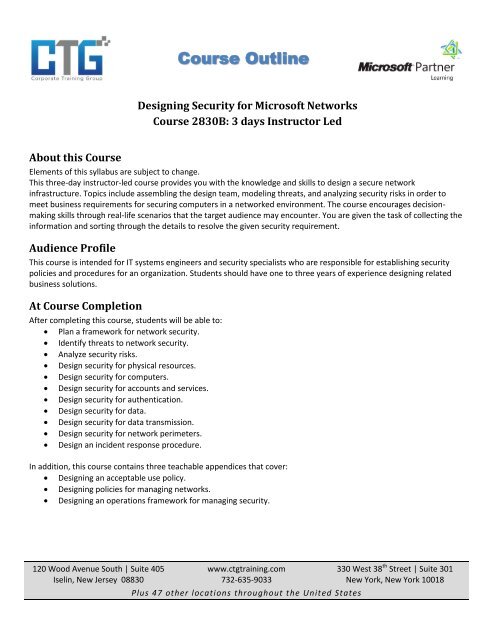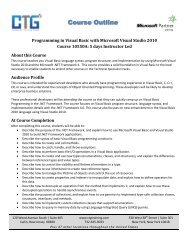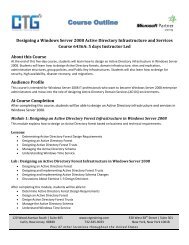New CTG Course Outline Template
New CTG Course Outline Template
New CTG Course Outline Template
Create successful ePaper yourself
Turn your PDF publications into a flip-book with our unique Google optimized e-Paper software.
<strong>Course</strong> <strong>Outline</strong>Designing Security for Microsoft Networks<strong>Course</strong> 2830B: 3 days Instructor LedAbout this <strong>Course</strong>Elements of this syllabus are subject to change.This three-day instructor-led course provides you with the knowledge and skills to design a secure networkinfrastructure. Topics include assembling the design team, modeling threats, and analyzing security risks in order tomeet business requirements for securing computers in a networked environment. The course encourages decisionmakingskills through real-life scenarios that the target audience may encounter. You are given the task of collecting theinformation and sorting through the details to resolve the given security requirement.Audience ProfileThis course is intended for IT systems engineers and security specialists who are responsible for establishing securitypolicies and procedures for an organization. Students should have one to three years of experience designing relatedbusiness solutions.At <strong>Course</strong> CompletionAfter completing this course, students will be able to: Plan a framework for network security. Identify threats to network security. Analyze security risks. Design security for physical resources. Design security for computers. Design security for accounts and services. Design security for authentication. Design security for data. Design security for data transmission. Design security for network perimeters. Design an incident response procedure.In addition, this course contains three teachable appendices that cover: Designing an acceptable use policy. Designing policies for managing networks. Designing an operations framework for managing security.120 Wood Avenue South | Suite 405Iselin, <strong>New</strong> Jersey 08830www.ctgtraining.com732-635-9033Plus 47 other locations throughout the United States330 West 38 th Street | Suite 301<strong>New</strong> York, <strong>New</strong> York 10018
<strong>Course</strong> <strong>Outline</strong>Module 1: Introduction to Designing SecurityA security design is a comprehensive plan that guides the implementation of security policies and procedures for anorganization. A security design helps an organization to organize its assets to implement security in a consistent andeffective manner.This module describes the basic framework for designing network security and introduces key concepts used throughoutthe course. It also introduces a fictional organization which the labs in the course use as an ongoing case study.Lessons Introduction to Designing Security for Microsoft Networks Contoso Pharmaceuticals: A Case StudyAfter completing this module, students will be able to: Provide an overview of designing security for Microsoft networks. Describe the components of the case study for this course.Module 2: Creating a Plan for Network SecurityPlans for network security include documented security policies and procedures. These policies and procedures, whenimplemented, help to secure networks against compromises. This module describes the importance of security policiesand procedures in a security design, and explains how a security design team must include representation from variousmembers of the organization. The module also introduces the Microsoft Solutions Framework (MSF) process model,which provides a comprehensive framework that can be used to create a security design.Lessons Introduction to Security Policies Designing Security by Using a Framework Creating a Security Design TeamLab : Creating a Plan for Network Security Exercise 1: Identifying Reasons Why Security Policies Fail Exercise 2: Determining the Members of a Security Design TeamAfter completing this module, students will be able to: Describe common elements of security policies and procedures. Create a security design framework by using the MSF process model. Create a security design team.Module 3: Identifying Threats to Network SecurityWithout security measures and controls in place, your data may be subjected to an attack. Some attacks are passive,which means that information is monitored; others are active, which means that the information is altered with intentto corrupt or destroy the data or the network itself.120 Wood Avenue South | Suite 405Iselin, <strong>New</strong> Jersey 08830www.ctgtraining.com732-635-9033Plus 47 other locations throughout the United States330 West 38 th Street | Suite 301<strong>New</strong> York, <strong>New</strong> York 10018
<strong>Course</strong> <strong>Outline</strong>Your networks and data are vulnerable to any of these types of attacks if you do not have a security plan in place.In this module, you will learn how to identify possible threats to a network and understand common motivations ofattackers. The module introduces the STRIDE (Spoofing, Tampering, Repudiation, Information disclosure, Denial ofservice, Elevation of privilege) threat model as an effective way to predict where threats may occur in an organization.Lessons Introduction to Security Threats Predicting Threats to SecurityLab : Identifying Threats to Network Security Exercise 1: Identifying and Categorizing Threats by Using a Threat Model Exercise 2: Documenting Security ThreatsAfter completing this module, students will be able to: Explain common network vulnerabilities and how attackers can exploit them. Predict threats to security by using a threat model.Module 4: Analyzing Security RisksMany organizations cannot react to new security threats before their business is affected. Managing the security of theirinfrastructures—and the business value that those infrastructures deliver—has become a primary concern forinformation technology (IT) departments.The Microsoft approach to security risk management is proactive and can assist organizations of all sizes with theirresponse to the requirements presented by these environmental and legal challenges. A formal security riskmanagement process enables enterprises to operate in the most cost-efficient manner by adopting a known andacceptable level of business risk. It also gives organizations a consistent, clear path to organize and prioritize limitedresources in order to manage risk.In this module, you will learn how to determine what resources in your organization require protection and how toprioritize those resources based on their value. You will then develop a risk management plan, based on the MOF riskmodel, to identify and analyze risks proactively and to determine an appropriate level of protection for each resource.Lessons Introduction to Risk Management Creating a Risk Management PlanLab : Analyzing Security Risks Exercise 1: Applying Quantitative and Qualitative Risk Analysis120 Wood Avenue South | Suite 405Iselin, <strong>New</strong> Jersey 08830www.ctgtraining.com732-635-9033Plus 47 other locations throughout the United States330 West 38 th Street | Suite 301<strong>New</strong> York, <strong>New</strong> York 10018
<strong>Course</strong> <strong>Outline</strong>After completing this module, students will be able to: Explain the purpose and operation of risk management. Create a risk management plan.Module 5: Designing Physical Security for Network ResourcesPhysical security refers to physical measures designed to safeguard personnel, property, and information. The termapplies to architectural features such as location, layout, barriers, doors, locks and bolts, and lighting, but also includesmeasures such as access control systems, alarm systems, and CCTV systems.In this module, you will determine threats and analyze physical risks to resources in an organization. You will then learnhow to design security for facilities, computers, mobile devices, and hardware. You will also learn about implementingdisaster recovery as a way to protect physical resources. This module focuses on physical access to resources and how toprotect them. Other modules will focus on access to data and how to protect it.Lessons Creating a Plan for Physical Security Creating a Design for Physical Security of Network ResourcesLab : Designing Physical Security for Network Resources Exercise 1: Identifying Potential Physical Vulnerabilities Exercise 2: Implementing CountermeasuresAfter completing this module, students will be able to: Create a plan for physical security. Create a design for physical security of network resources.Module 6: Designing Security for Network HostsThe Windows Server 2003, Windows XP Professional, and Windows Vista operating systems provide many features andcapabilities that you can use to configure and maintain a secure network operating environment. In fact, there aresecurity capabilities in nearly every area of Windows. Many of these security features and capabilities have been addedor enhanced since the introduction of the Microsoft Windows 2000 Professional and Windows 2000 Server operatingsystems.In this module, you will learn how to determine threats and analyze risks to network hosts in an organization. You willalso learn how to design security for network hosts throughout their life cycles, from initial purchase todecommissioning.Lessons Creating a Security Plan for Network Hosts Creating a Design for the Security of Network Hosts120 Wood Avenue South | Suite 405Iselin, <strong>New</strong> Jersey 08830www.ctgtraining.com732-635-9033Plus 47 other locations throughout the United States330 West 38 th Street | Suite 301<strong>New</strong> York, <strong>New</strong> York 10018
<strong>Course</strong> <strong>Outline</strong>Lab : Designing Security for Network Hosts Exercise 1: Identifying Vulnerabilities When Applying Security Updates Exercise 2: Identifying Vulnerabilities When Decommissioning ComputersAfter completing this module, students will be able to: Create a security plan for network hosts. Create a design for the security of network hosts.Module 7: Designing Security for Accounts and ServicesComputer networks use accounts to grant users, applications, and network services access to the information on anetwork. Network services are server applications that are usually hosted on dedicated server computers.If an attacker gains access to an account that has excessive privileges, or breaks the password that is associated with anaccount, the attacker can obtain authorized access to a network.Windows services are executable programs that run in sessions outside the session that the user who is currently loggedon is using. In this way, services run in the background, independent of any user session. Services can start automaticallywhen the computer starts, and can also be paused and restarted. Services may not show a user interface, although theytypically communicate with a user interface to control and administer the service. Because of this behavior, services areideal for use on a server or whenever you require long-term functionality that does not interfere with other users whoare working on the same computer. In addition to services that Microsoft has created, many third-party vendors designproducts to be deployed as services running continuously in the background. Antivirus services are an example of thistype of product.In this module, you will learn how to determine threats and analyze risks to accounts and services in an organization.You will also learn how to design security for accounts and services, including determining security requirements,creating policies, and designing strategies to manage security.Lessons Creating a Security Plan for Accounts Creating a Security Plan for Services Creating a Design for Security of Accounts and ServicesLab : Designing Security for Accounts and Services Exercise 1: Identifying Potential Account Vulnerabilities Exercise 2: Applying CountermeasuresAfter completing this module, students will be able to: Create a security plan for accounts. Create a security plan for services. Create a design for security of accounts and services.120 Wood Avenue South | Suite 405Iselin, <strong>New</strong> Jersey 08830www.ctgtraining.com732-635-9033Plus 47 other locations throughout the United States330 West 38 th Street | Suite 301<strong>New</strong> York, <strong>New</strong> York 10018
<strong>Course</strong> <strong>Outline</strong>Module 8: Designing Security for AuthenticationIn this module, you will learn how to determine threats and analyze risks to authentication. You will learn how to designsecurity for authenticating local users, remote users, and users who access your network across the Internet. You willalso learn when to choose multifactor authentication for additional security.Lessons Creating a Security Plan for Authentication Creating a Design for Security of AuthenticationLab : Designing Security for Authentication Exercise 1: Identifying Potential Authentication Vulnerabilities Exercise 2: Applying CountermeasuresAfter completing this module, students will be able to: Create a security plan for authentication. Create a design for security of authentication.Module 9: Designing Security for DataBusiness data is one of the most valuable resources in many organizations. If data were to be irreparably damaged, lost,or exposed to competitors, many organizations would be adversely affected and perhaps even driven out of business.For client hosts, protecting data can be particularly daunting because portable computers can be stolen from mobileusers, and backing up data for mobile users is very difficult. Protecting data that is stored on servers is still a significantchallenge, but for most organizations it is one that is achievable. For these reasons, many companies require their endusers to store their critical data on servers managed by their information technology (IT) department. Data can beprotected through the use of access control lists (ACLs) on files and folders, by using encryption, and by using aneffective backup and restore strategy.In this module, you will learn how to determine threats and analyze risks to data in an organization. You will learn howto design an access control model for files and folders in order to protect data that is stored on network servers. You willalso learn about considerations for encrypting and managing data.Lessons Creating a Security Plan for Data Creating a Design for Security of DataLab : Designing Security for Data Exercise 1: Identifying Potential Data Vulnerabilities Exercise 2: Designing CountermeasuresAfter completing this module, students will be able to: Create a security plan for data.120 Wood Avenue South | Suite 405Iselin, <strong>New</strong> Jersey 08830www.ctgtraining.com732-635-9033Plus 47 other locations throughout the United States330 West 38 th Street | Suite 301<strong>New</strong> York, <strong>New</strong> York 10018
<strong>Course</strong> <strong>Outline</strong>Create a design for security of data.Module 10: Designing Security for Data TransmissionIn this module, you will learn how to determine threats and analyze risks to data transmission in an organization. Youwill also learn how to design security for various types of data transmission, including traffic on local area networks(LANs), wide area networks (WANs), Virtual Private Networks (VPNs), wireless networks, and the Internet.Lessons Creating a Security Plan for Data Transmission Creating a Design for Security of Data TransmissionLab : Designing Security for Data Exercise 1: Identifying Potential Data Transmission Vulnerabilities Exercise 2: Implementing CountermeasuresAfter completing this module, students will be able to: Create a security plan for data transmission. Create a design for security of data transmission.Module 11: Designing Security for Network PerimetersProperly configured firewalls and border routers are the cornerstone of perimeter security. However, all of these devicesmust be properly secured because the entire network is put at risk when any one of them is compromised.Organizations must therefore invest time and resources in securing not only the Virtual Private Network (VPN) serversand the remote access servers (RAS), but also the mobile computers that are used to connect to those servers. To dobusiness on and through the Internet, organizations must make some of their business applications and data accessiblethrough the Internet. Traditional packet-filtering firewalls block network ports and computer addresses, but ports mustbe opened for the business applications. This means that your organization requires firewalls or proxy servers that areapplication-aware and capable of filtering network traffic at the application layer.In this module, you will learn how to determine threats and analyze risks to network perimeters. You will also learn howto design security for network perimeters, including perimeter networks (also known as DMZs, demilitarized zones, andscreened subnets), and for computers that connect directly to the Internet.Lessons Creating a Security Plan for the Perimeter of a Network Creating a Design for Security of Network PerimetersLab : Designing Security Network Perimeters Exercise 1: Identifying Potential Perimeter Network Vulnerabilities Exercise 2: Implementing Countermeasures120 Wood Avenue South | Suite 405Iselin, <strong>New</strong> Jersey 08830www.ctgtraining.com732-635-9033Plus 47 other locations throughout the United States330 West 38 th Street | Suite 301<strong>New</strong> York, <strong>New</strong> York 10018
<strong>Course</strong> <strong>Outline</strong>After completing this module, students will be able to: Create a security plan for the perimeter of a network. Create a design for security of network perimeters.Module 12: Responding to Security IncidentsNetwork security for an organization is an exercise in prevention. A good security design that is properly implementedwill prevent most of the most common attacks. However, it is very likely that an attacker will eventually penetrate thedefenses that you design.When an attack happens, the key to limiting damage is early detection and a rapid and orderly response. Auditing is animportant tool to help you to detect network abnormalities that may indicate attacks. An incident response procedure isa series of steps that you design in advance to guide your organization during a security incident.Lessons Introduction to Auditing and Incident Response Designing an Audit Policy Designing and Incident Response ProcedureLab : Responding to Security Incidents Exercise 1: Identifying Potential Vulnerabilities Exercise 2: Implementing an Incident Response Team Exercise 3: Implementing an Incident Response PlanAfter completing this module, students will be able to: Describe auditing and incident response. Design an audit policy. Design an incident response procedure.Module 13: Appendix A: Designing an Acceptable Use PolicyThis appendix provides information about creating policies for acceptable use of network resources by users.Lessons Analyzing Risks That Users Introduce Designing Security for Computer UseModule 14: Appendix B: Designing Policies for Managing NetworksThis appendix offers guidelines for ensuring that network administrators manage networks in a secure manner.Lessons Analyzing Risks to Managing Networks Designing Security for Managing Networks120 Wood Avenue South | Suite 405Iselin, <strong>New</strong> Jersey 08830www.ctgtraining.com732-635-9033Plus 47 other locations throughout the United States330 West 38 th Street | Suite 301<strong>New</strong> York, <strong>New</strong> York 10018
<strong>Course</strong> <strong>Outline</strong>Module 15: Appendix C: Designing an Operations Framework to Manage SecurityThis appendix explains how to create a framework to ensure security of a network as the network changes and as thesecurity requirements of the organization change.Lessons Analyzing Risks to Ongoing Network Operations Designing a Framework for Ongoing Network Operations120 Wood Avenue South | Suite 405Iselin, <strong>New</strong> Jersey 08830www.ctgtraining.com732-635-9033Plus 47 other locations throughout the United States330 West 38 th Street | Suite 301<strong>New</strong> York, <strong>New</strong> York 10018
















